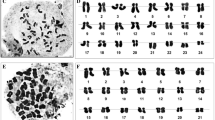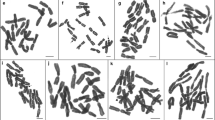Abstract
Zingiberaceae has reportedly undergone frequent polyploidization and hybridization events. Here we describe the new chromosome counts and karyomorphological details for the three important members of the family. Root tip cells of plants of Alpinia zerumbet (earlier reported to be 2n = 48, 40) and Globba marantina (reportedly 2n = 44 to 2n = 96) showed 2n = 52 chromosomes, both being aneuploids, Hedychium spicatum plants (2n = 34 according to previous reports) were found to be tetraploid with somatic chromosome number of 2n = 68. Detailed karyomorphological analyses performed using various parameters revealed that all the three novel cytotypes had moderately symmetrical karyotypes with low levels of intra– and interchromosomal variation in terms of both chromosome lengths and centromeric indices.

Similar content being viewed by others
References
Beltran IC, Kiew KY. Cytotaxonomic studies in the Zingiberaceae. Notes Roy Bot Gard Edinb. 1984;41:541–59.
Bhattacharyya NK. Some experimental aspects on the cytogenetics of species and some fundamental studies on the chromosomes of plants. Ph.D. Dissertation, University of Calcutta, Kolkata, India; 1957.
Chakravorti AK. Multiplication of chromosome numbers with relation to speciation in Zingiberaceae. Sci Cult. 1948;14:137–40.
Chen ZY. Evolutionary patterns in cytology and pollen structure of Asian Zingiberaceae. In: Holm-Nielsen B, Nielsen IC, Balslev H, editors. Tropical forests. New York: Academic Press Limited; 1989. p. 185–91.
Darlington CD, Wylie AP. Chromosome atlas of flowering plants. 2nd ed. London: George Allen & Unwin; 1955. p. 345–6.
Dutta M, Bandyopadhyay M. Comparative karyomorphological studies of three edible locally important species of Allium from India. Nucleus. 2014;57:25–31.
Gao L, Liu N, Huang B, Hu X. Phylogenetic analysis and genetic mapping of Chinese Hedychium using SRAP markers. Sci Hortic. 2008;117:369–77.
Guerra M. Chromosome numbers in plant cytotaxonomy: concepts and implications. Cytogenet Genome Res. 2008;120:339–50.
Islam MA. Genetic diversity of the genus Curcuma in Bangladesh and further biotechnological approaches for in vitro regeneration and long– term conservation of C. longa germplasm. Ph.D. Dissertation, University of Hannover, Hannover, Germany; 2004.
Joseph R. Karyomorphometrical analysis and exploration of major essential oil constituents in Zingiberaceae. Ph.D. Dissertation, Mahatma Gandhi University, Kerala, India; 1998.
Kress WJ, Prince LM, Williams KJ. The phylogeny and a new classification of the gingers (Zingiberaceae): evidence from molecular data. Am J Bot. 2002;89:1682–96.
Levan A, Fredga K, Sandberg AA. Nomenclature for centromeric position on chromosomes. Hereditas. 1964;52:201–20.
Levitsky GA. The karyotype in systematics. Bull Appl Bot Gen Pl–Breed. 1931;27:220–40.
Mahanty HK. A cytological study of the Zingiberales with special reference to their taxonomy. Cytologia. 1970;35:13–49.
Mandi KK. Studies on chromosomes, DNA estimation and chemical constituents of different members of Scitaminae. Ph.D. Dissertation, University of Calcutta, Kolkata, India; 1990.
Mukherjee I. Chromosome studies of some species of Hedychium. Bot Mag (Tokyo). 1970;83:237–41.
Paszko B. A critical review and a new proposal of karyotype asymmetry indices. Plant Syst Evol. 2006;258:39–48.
Raghavan TS, Venkatasubban KR. Cytological studies in the family Zingiberaceae with special reference to chromosome number and cyto–taxonomy. Proc Natl Acad Sci India Sect B (Biol Sci). 1943;17:118–32.
Ramachandran K. Chromosome numbers in Zingiberaceae. Cytologia. 1969;34:213–21.
Sabu M. Zingiberaceae and Costaceae of South India. 1st edn. Calicut University (India): Indian Association for Angiosperm Taxonomy; 2006.
Sharma AK, Bhattacharya NK. Cytology of several members of Zingiberaceae. La Cellule. 1959;59:297–346.
Škorničková JL, Šida O, Jarolimova V, Sabu M, Fer T, Travnicek P, et al. Chromosome numbers and genome size variation in Indian species of Curcuma (Zingiberaceae). Ann Bot. 2007;100:505–26.
Stace CA. Cytology and cytogenetics as a fundamental taxonomic resource for the 20th and 21st centuries. Taxon. 2000;49:451–77.
Stebbins GL. Chromosomal evolution in higher plants. 1st ed. London: Edward Arnold (Publishers) Ltd; 1971.
Takano A. Cytological analyses of 19 taxa in Globba (Zingiberaceae). Acta Phytotax Geobot. 2001;52:64–74.
Watanabe K, Yahara T, Denda T, Kosuge K. Chromosomal evolution in the genus Brachyscome (Asteraceae, Astereae): statistical tests regarding correlation between changes in karyotype and habit using phylogenetic information. J Plant Res. 1999;112:145–61.
Zarco CR. A new method for estimating karyotype asymmetry. Taxon. 1986;35:526–30.
Acknowledgments
The authors acknowledge the financial support provided by CAS, Department of Botany, University of Calcutta, India towards this research work. The authors would also like to acknowledge National Bureau of Plant Genetic Resources, India for providing plant materials for the research work, and, Prof. Abhaya Prasad Das, Department of Botany, North Bengal University, India for allowing the submission of voucher specimen in NBU-Herbarium.
Author information
Authors and Affiliations
Corresponding author
Rights and permissions
About this article
Cite this article
Bhadra, S., Bandyopadhyay, M. New chromosome number counts and karyotype analyses in three important genera of Zingiberaceae. Nucleus 59, 35–40 (2016). https://doi.org/10.1007/s13237-016-0162-7
Received:
Published:
Issue Date:
DOI: https://doi.org/10.1007/s13237-016-0162-7




